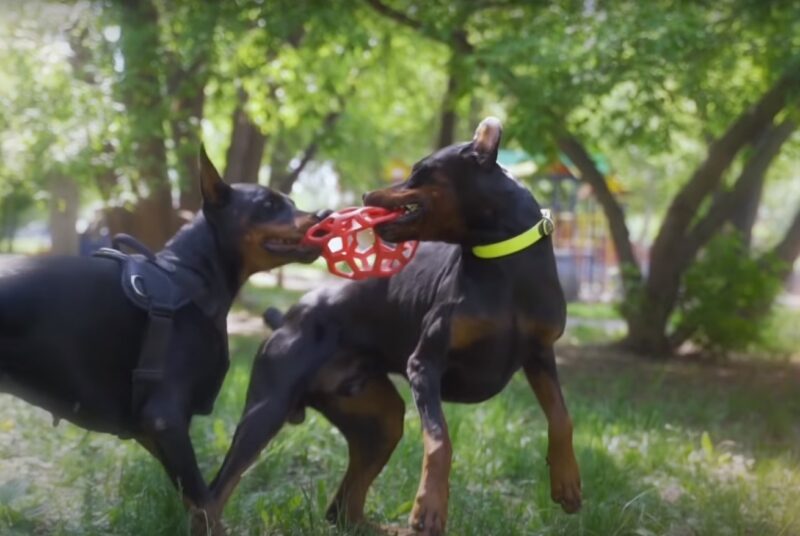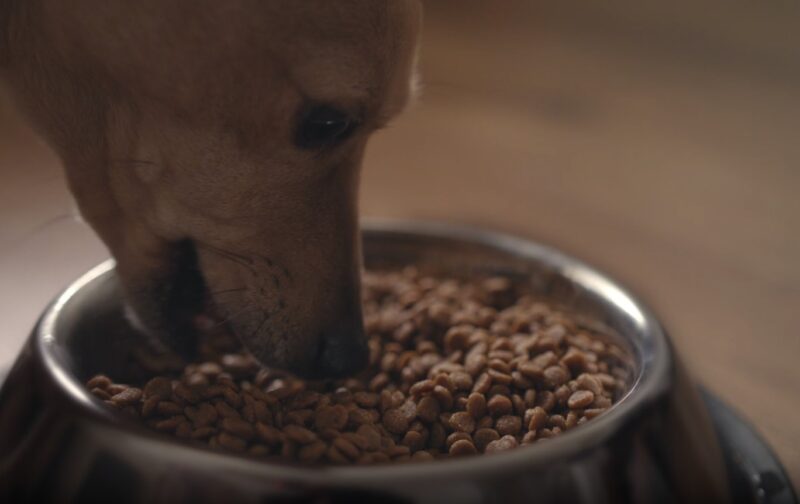Just like people, or any living organism for that matter, dogs need to be fed the correct amount of food to maintain optimal health. If don’t feed your dog enough, or feed him too much, your dog will suffer from a number of easily avoidable health issues.
We’ll discuss how much food to feed your dog, but first here’s what can happen to your dog when you do not feed him properly.
Too Little Food
Malnutrition is a form of animal abuse. However, not every owner attentionally abuses their dog. Sometimes they lack education about proper canine nutrition. Here are the telltale symptoms of malnutrition according to Cuteness.com:
- Ribs, spine and bones are visible from a distance, indicating little to no body fat and no muscle mass.
- The dog’s coat may be scruffy or lack soft fur. He has dry skin or dandruff.
- Gas and fecal matter may be odoriferous; fecal matter may be extremely runny or hard.
- The dog may vomit bile.
- Low energy level.
- Susceptible to illness.

Too Much Food
Dogs, like people, are prone to overeating. A common reason people overfeed their dogs is because eating makes dogs happy—and owners love happy dogs. However, overeating has consequences. According to Petful.com, they include:
- A poorer quality of life, and shorter life at that.
- Osteoarthritis.
- Intervertebral Disk Disease (a condition that can paralyze a dog).
- Subclinical conditions, such as inflammation and high cholesterol (which can lead to pancreatitis, diabetes, gastrointestinal disease and more).
- Breathing and heart problems.
How Much To Feed Your Dog?
According to Petmd.com, here is a chart that shows how much to feed your dog.
| Weight of Dog | Amount per Day |
|---|---|
| 5 pounds or 2-3 kg | ½ cup – ⅝ cup or 65 g |
| 10 pounds or 4-5 kg | ¾ cup – 1 cup or 100 g |
| 20 pounds or 9-14 kg | 1¼ cups – 1¾ cups or 180 g |
| 40 pounds or 18 kg | 2¼ – 3 cups or 305 g |
| 60 pounds or 27 kg | 3 cups – 4 cups or 410 g |
| 80 pounds or 36 kg | 3⅔ – 5 cups or 510 g |
| 100 pounds or 45 kg | 4¼ – 6 cups or 610 g |
Ensuring your dog is eating the right amount is crucial for their health and happiness. The consequences of underfeeding or overfeeding can be severe, affecting their quality of life, susceptibility to diseases, and even their lifespan.
However, every dog is unique, and their needs can vary based on factors like age, breed, metabolism, and lifestyle. While the chart offers a basic guideline, it’s important to tailor your dog’s diet to their specific needs.
Here are some factors to consider:
- Age: Puppies, adult dogs, and seniors have different nutritional requirements. Puppies, for instance, need more calories and nutrients to support their rapid growth, while older dogs may need fewer calories to avoid weight gain as their activity level decreases.
- Breed: Certain breeds have specific dietary needs or are prone to specific health issues that can be managed or mitigated with the right diet. For example, large breed dogs may require food that supports joint health to prevent issues like hip dysplasia.
- Health Status: Dogs with health conditions such as diabetes, allergies, or digestive issues may require special diets formulated to manage these conditions.
- Neutered/Spayed: Neutering or spaying can affect your dog’s metabolism, often leading to a lower energy requirement. Adjusting their food intake can help prevent weight gain.
Quality of Food
The quality of your dog’s food also plays a significant role in their overall health. Look for foods that list real meat as the first ingredient, and avoid those with excessive fillers, artificial colors, or preservatives.
The right balance of proteins, fats, carbohydrates, vitamins, and minerals is essential for maintaining your dog’s health.
Dog’s Weight
Regularly monitoring your dog’s weight and body condition is vital. You should be able to feel (but not see) their ribs without much fat covering them.
They should have a visible waist when viewed from above and a tuck in their abdomen when viewed from the side. Adjust their diet as needed to maintain an ideal body condition.
Consultation with a Vet
It’s always advisable to consult with a veterinarian to determine the best diet for your dog, especially if you’re considering major changes or if your dog has special dietary needs.
A vet can provide personalized advice based on a thorough understanding of your dog’s health.
Always use Treats
Treats are an important tool for training and bonding, but they should be given in moderation. Treats should not make up more than 10% of your dog’s daily caloric intake to avoid weight gain and nutrient imbalance.
Exercise and Diet
Adequate exercise is as important as diet for maintaining your dog’s health. Regular physical activity helps manage weight, improves cardiovascular health, and can strengthen the bond between you and your dog.
Active Dogs

Some dogs are naturally more active by virtue of their breed, or how much activity you give them. Is your dog an “athlete”? Consider feeding active dogs a little bit more than the chart’s recommendations.
P.S. Water is also a crucial component of a dog’s diet. Make sure your dog always has clean, clear water daily that is easily accessible. Your dog’s bowl should be filled at all times. A healthy dog will drink as much as he needs to stay hydrated.
FAQs
Do dogs live longer if you feed them less?
There is no clear evidence that feeding dogs less will make them live longer. However, feeding dogs the appropriate amount of calories and nutrients for their size, age, and activity level can help them maintain a healthy weight and prevent obesity-related health problems.
Can I walk my dog 30 minutes after eating?
It is generally recommended to wait at least an hour after feeding your dog before taking them for a walk. Walking your dog too soon after eating can cause digestive issues, such as vomiting, diarrhea, and bloating. It can also increase the risk of a life-threatening condition called gastric dilatation-volvulus (GDV), where the stomach twists and traps gas inside.
How much should a 7 kg dog eat?
The amount of food a 7 kg dog should eat depends on the type and quality of the food, as well as the dog’s age, activity level, and health status. A general guideline is to feed your dog about 2% to 3% of their body weight per day, divided into two meals. For a 7 kg dog, this would be about 140 to 210 grams of food per day.
Should dogs eat more in the morning or evening?
There is no definitive answer to this question, as different dogs may have different preferences and needs. However, some benefits of feeding your dog more in the morning are that it can provide them with energy for the day, keep their blood glucose levels stable, and help them digest their food better.
Summary
Feeding your dog the correct amount of food is essential for their health and well-being, preventing issues stemming from both underfeeding and overfeeding.
The amount of food a dog requires varies by weight, with specific daily amounts recommended based on the dog’s size. Yet, these guidelines should be adjusted for individual needs, considering factors like age, breed, health status, and whether the dog is neutered/spayed.
We are also covering other topics related to pets. If you have a clingy dog, you should read more about why it prefer sleeping in your bed.
